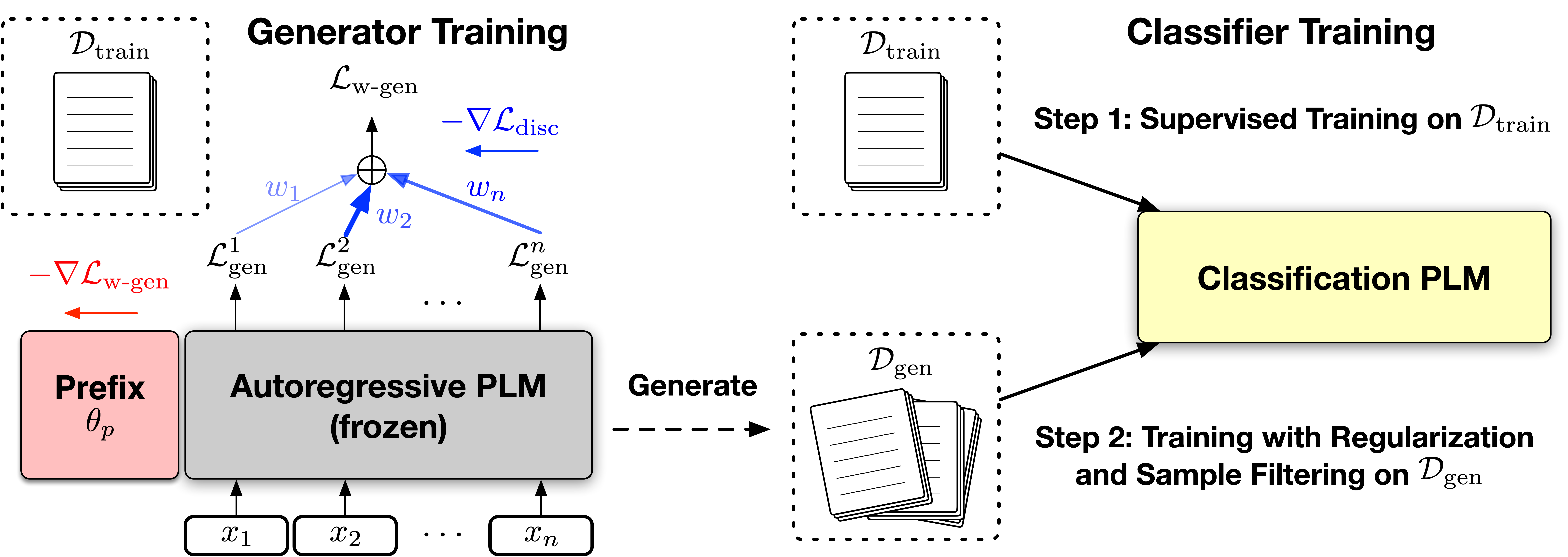The source code for Tuning Language Models as Training Data Generators for Augmentation-Enhanced Few-Shot Learning, published in ICML 2023.
Before running, you need to first install the required packages by typing following commands (Using a virtual environment is recommended):
pip3 install -r requirements.txt
FewGen is a Few-shot data Generation method for NLU tasks. FewGen first tunes a generative language model on the few-shot samples and then synthesizes novel training data as augmentations.
You need to download the few-shot data splits defined in LM-BFF by running the following commands:
cd data
bash download_data.sh
cd ..
python utils/gen_k_shot.py
Pretraining Corpus for Sequence-Pair Tasks: We provide the processed pretraining corpus (Wikipedia and OpenWebText) for generating training data for sequence-pair tasks under the pretrain_corpus directory; see the README file there for details.
The generated training data used in the paper are provided as gen-train.json files under the dataset directory corresponding to each task and seed (e.g., data/k-shot/CoLA/16-13/gen-train.json). If you do not want to train the generator to generate the synthetic data on your own, you could skip this section and the next, and directly jump to the Training the Classifier Section. Otherwise, follow the steps below to train the generator on the few-shot samples and generate synthetic data (next section) yourself.
Training Script: The generator will be trained with prefix-tuning on the few-shot samples. The training will be conducted by running bash train_gen.sh $GPU $TASK $SEED, where $GPU is the CUDA device ID (e.g., 0), $TASK is the task (e.g., MNLI), $SEED is the seed (from [13, 21, 42, 87, 100]).
GPU Memory Requirement: The default setting (i.e., unmodified code) requires ~30GB of a single GPU for tuning the generator. If your GPU does not meet the memory requirement, you could (1) disable meta-weight learning by excluding the --meta_weight command line argument in the train_gen.sh file here (which will reduce the GPU memory requirement and will result in slightly worsened but still decent generators), or (2) use a smaller generator model.
After the generator is tuned on the few-shot samples, we can use it to generate novel training samples.
Data Generation Script: Run bash gen_train_data.sh $GPU $TASK $SEED $LABEL $NUM_GEN, where $GPU is the CUDA device ID (e.g., 0), $TASK is the task (e.g., MNLI), $SEED is the seed (from [13, 21, 42, 87, 100]),$LABEL is the label conditioned on which the data are generated (e.g., entailment), and $NUM_GEN is the number of samples to be generated (e.g., 5000). The generated data will be saved under gen_res_${TASK}_${SEED} as json files.
Combining Generated Data to Construct the Training Set: After generating the training data for each label separately, we need to combine them to form the training set by running python utils/gen_utils.py --task $TASK --seed $SEED where $TASK is the task (e.g., MNLI) and $SEED is the seed (from [13, 21, 42, 87, 100]). The training set will be saved under data/k-shot/$TASK/16-$SEED as gen-train.json files.
The classifier training consists of two steps: First train on the few-shot samples and then continue training on the synthetic data.
Classifier Fine-Tuning on Few-Shot Samples: We first train the classification model on the original few-shot training set. This can be done by running bash run_finetune_on_fewshot.sh $GPU $TASK $SEED $LR $BS, where $GPU is the CUDA device ID (e.g., 0), $TASK is the task (e.g., MNLI), $SEED is the seed (from [13, 21, 42, 87, 100]), $LR is the learning rate (e.g., 1e-5) and BS is the batch size (e.g., 4). The training logs, results and tuned checkpoints will be saved under fewshot_result/$TASK/$SEED/.
Selecting the Best Model for Continued Training on Synthetic Data: Next, we need to select the best-performing model out of all hyperparameter combinations based on the dev set results. This can be done by running python utils/get_best_fewshot_model.py --dir fewshot_result/$TASK/$SEED/, where $TASK is the task (e.g., MNLI) and $SEED is the seed (from [13, 21, 42, 87, 100]). The selected model checkpoint will be copied to fewshot_result/$TASK/$SEED/best.
Classifier Fine-Tuning on Generated Samples: Finally, we continue training the selected model checkpoint on our generated training sets by running bash run_finetune_on_gen.sh $GPU $TASK $SEED, where $GPU is the CUDA device ID (e.g., 0), $TASK is the task (e.g., MNLI) and $SEED is the seed (from [13, 21, 42, 87, 100]). The training logs, results and tuned checkpoints will be saved under final_result/$TASK/$SEED/. The test set results report can be generated by running python utils/get_final_result.py.
Some scripts in this repository are adapted from SuperGen (for training data generation), LM-BFF (for prompt-based fine-tuning) and huggingface transformers (for GLUE processor and trainer).
Please cite the following paper if you find the code helpful for your research.
@inproceedings{Meng2023TuningLM,
title={Tuning Language Models as Training Data Generators for Augmentation-Enhanced Few-Shot Learning},
author={Yu Meng and Martin Michalski and Jiaxin Huang and Yu Zhang and Tarek Abdelzaher and Jiawei Han},
booktitle={International Conference on Machine Learning},
year={2023}
}
